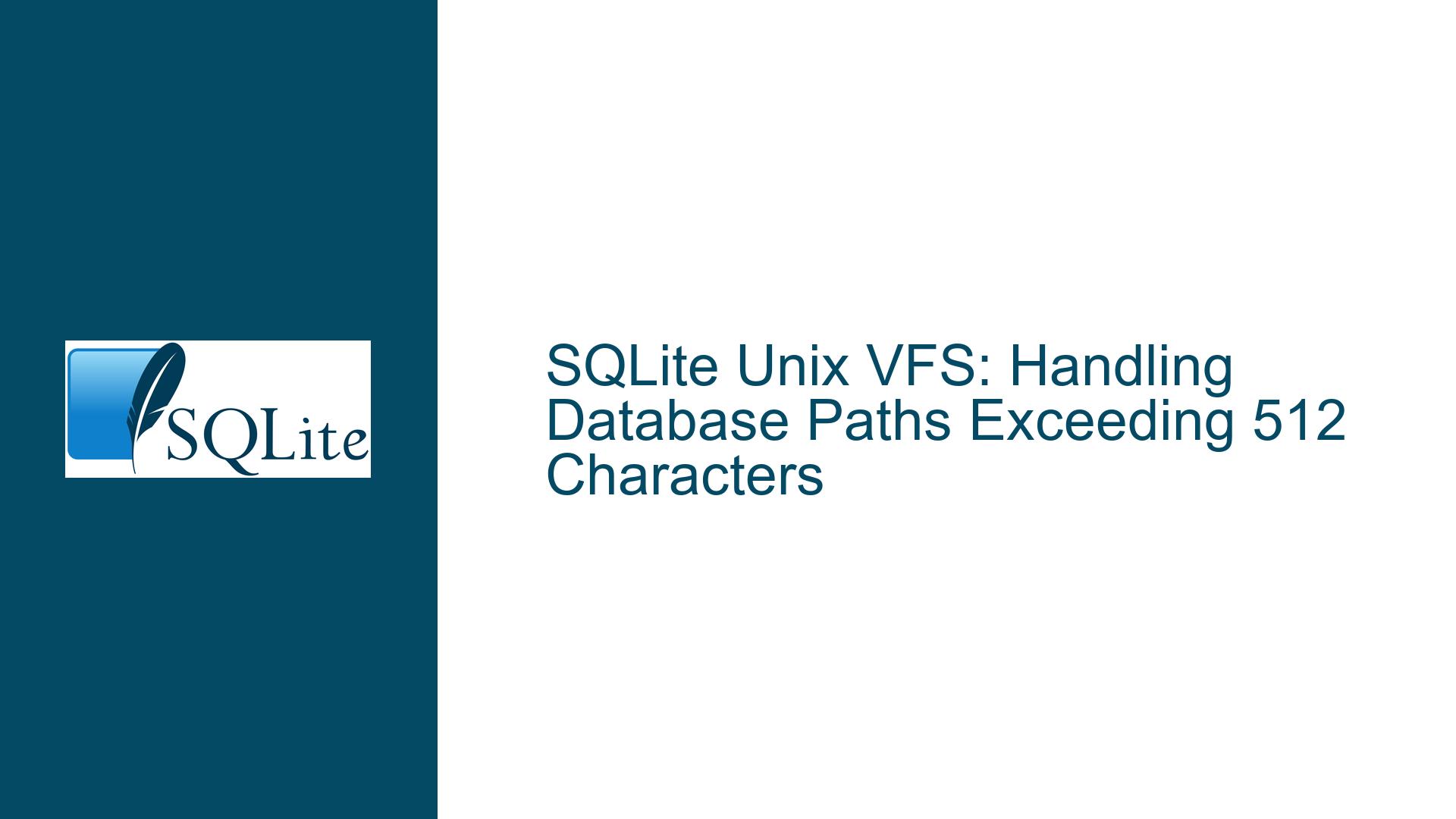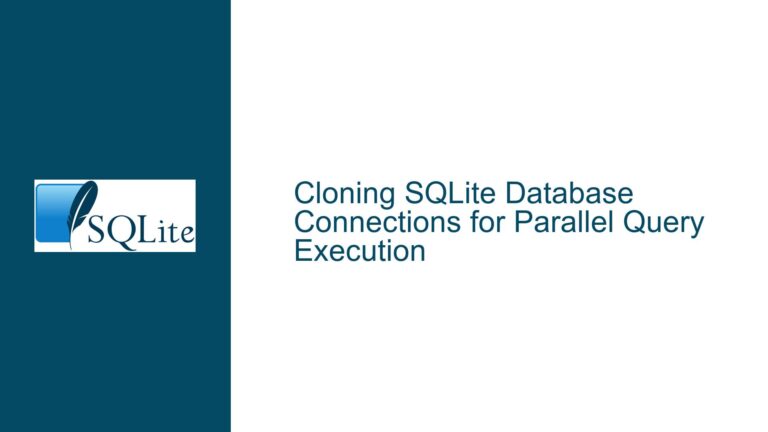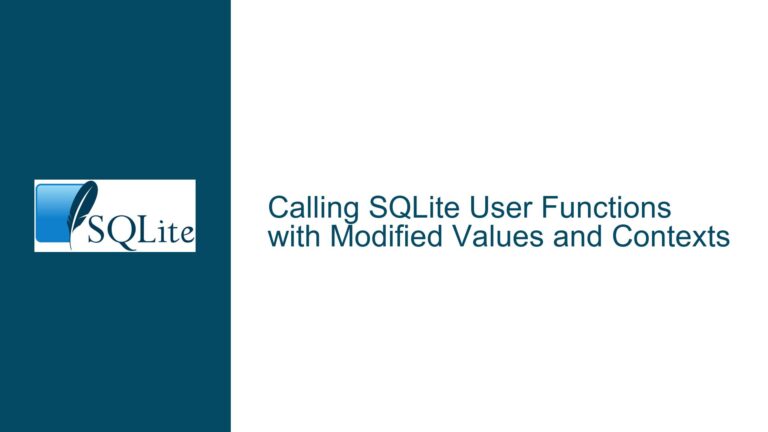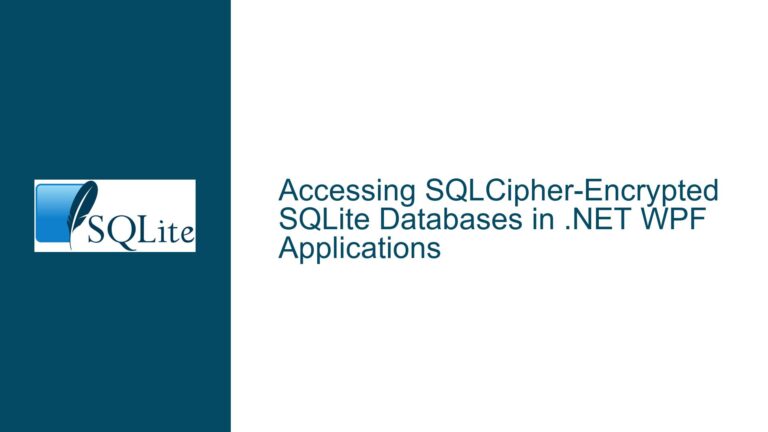SQLite Unix VFS: Handling Database Paths Exceeding 512 Characters
Issue Overview: SQLite Unix VFS Path Length Limitation
The core issue revolves around the SQLite Unix VFS (Virtual File System) imposing a hard-coded limit on the length of database file paths. Specifically, the MAX_PATHNAME constant in the SQLite source code is set to 512 characters, which includes the null-terminator. This means that any database file path exceeding 505 characters (512 minus the null-terminator and potential padding) will cause SQLite to fail when attempting to open the database. This limitation is particularly problematic in environments like the Yocto Project, where deeply nested directory structures are common, and paths can easily exceed this limit.
The MAX_PATHNAME limit is defined in the src/os_unix.c file of the SQLite source code, specifically at line 179: #define MAX_PATHNAME 512. This constant is used throughout the Unix VFS implementation to allocate buffers for file paths and to validate path lengths before attempting to open or manipulate files. While this limit may have been reasonable when SQLite was first developed, modern filesystems on Unix-like operating systems, particularly Linux, support much longer paths—up to 4096 characters in many cases. This discrepancy between SQLite’s internal limit and the capabilities of modern filesystems creates a significant usability issue for developers working with deeply nested directory structures.
The issue is further complicated by the fact that SQLite’s behavior is consistent across all Unix-like operating systems, regardless of the underlying filesystem’s capabilities. This means that even on systems where the filesystem supports longer paths, SQLite will still enforce the 512-character limit. This can lead to unexpected failures and workarounds that complicate application design and deployment. For example, developers may need to artificially shorten paths or use symbolic links to work around the limitation, which can introduce additional complexity and potential points of failure.
Possible Causes: Why the 512-Character Path Limit Exists
The 512-character path limit in SQLite’s Unix VFS implementation is rooted in historical and practical considerations. When SQLite was first developed, the 512-character limit was a common convention in Unix-like operating systems, reflecting the limitations of the filesystems and system APIs of the time. Many early Unix filesystems, such as the original UFS (Unix File System), had path length limits that were either explicitly or implicitly tied to the size of fixed-size buffers used in system calls and kernel data structures. These limits were often inherited by higher-level libraries and applications, including SQLite.
Another factor contributing to the 512-character limit is the desire for consistency across different platforms and operating systems. SQLite is designed to be a lightweight, portable database engine that can run on a wide variety of systems, from embedded devices to full-fledged servers. By enforcing a conservative path length limit, SQLite ensures that it can operate reliably on systems with limited resources or older filesystems that may not support longer paths. This approach minimizes the risk of compatibility issues and simplifies the codebase by avoiding platform-specific optimizations.
However, this conservative approach has become increasingly problematic as filesystems and operating systems have evolved. Modern Unix-like systems, particularly Linux, have significantly relaxed path length limits, with many filesystems supporting paths up to 4096 characters. This evolution has created a mismatch between SQLite’s internal limits and the capabilities of the underlying systems, leading to the issue at hand. While SQLite’s design philosophy emphasizes simplicity and portability, the 512-character path limit is now a source of friction for developers working with modern filesystems and directory structures.
Troubleshooting Steps, Solutions & Fixes: Addressing the Path Length Limitation
To address the 512-character path length limitation in SQLite’s Unix VFS, several approaches can be considered, ranging from immediate workarounds to long-term solutions. Each approach has its trade-offs, and the best choice depends on the specific requirements and constraints of the application.
Immediate Workarounds: Symbolic Links and Path Shortening
One immediate workaround is to use symbolic links to reduce the effective length of database file paths. By creating a symbolic link to the database file in a directory with a shorter path, developers can effectively bypass the 512-character limit. For example, if the database file is located at /very/long/path/to/database/file.db, a symbolic link can be created at /short/path/file.db that points to the original file. This allows SQLite to open the database using the shorter path, avoiding the path length limitation.
Another workaround is to artificially shorten the directory structure leading to the database file. This can be achieved by renaming directories or reorganizing the directory tree to reduce the overall path length. While this approach can be effective, it may not always be feasible, particularly in environments where the directory structure is dictated by external constraints or conventions.
Custom VFS Implementation: Extending Path Length Support
For applications that require full support for long paths, a custom VFS implementation can be developed to replace the default Unix VFS. This custom VFS can be designed to support longer paths by increasing the MAX_PATHNAME constant and modifying the relevant buffer allocations and validations. The custom VFS can also leverage platform-specific APIs to handle long paths more efficiently, such as using openat and related functions on Linux.
Developing a custom VFS requires a deep understanding of SQLite’s internal architecture and the Unix filesystem APIs. The custom VFS must implement all the necessary functions defined by the SQLite VFS interface, including file opening, reading, writing, and closing operations. Additionally, the custom VFS must handle edge cases and error conditions gracefully to ensure robust operation.
Upstream Changes: Proposing a Patch to SQLite
For a more permanent solution, developers can propose a patch to the SQLite project to increase the MAX_PATHNAME limit or make it configurable. This approach involves modifying the SQLite source code to support longer paths and submitting the changes for review and inclusion in future releases. The patch should include not only the increased path length limit but also any necessary changes to buffer allocations, validations, and error handling to ensure compatibility with existing applications.
When proposing a patch, it is important to consider the impact on different platforms and filesystems. The patch should be thoroughly tested on a variety of systems to ensure that it does not introduce regressions or compatibility issues. Additionally, the patch should be accompanied by documentation and test cases to facilitate review and integration by the SQLite development team.
Long-Term Considerations: Balancing Compatibility and Modernization
In the long term, the SQLite project may need to reconsider its approach to path length limits to better align with modern filesystem capabilities. This could involve making the MAX_PATHNAME limit configurable at compile time or runtime, allowing developers to adjust it based on their specific requirements. Alternatively, SQLite could adopt a more dynamic approach to path handling, using variable-length buffers or platform-specific APIs to support longer paths without imposing arbitrary limits.
Balancing compatibility and modernization is a key challenge for the SQLite project. While increasing the path length limit would address the immediate issue, it must be done in a way that maintains SQLite’s core principles of simplicity, portability, and reliability. This may require careful consideration of the trade-offs involved and collaboration with the broader SQLite community to develop a solution that meets the needs of all users.
In conclusion, the 512-character path length limitation in SQLite’s Unix VFS is a historical artifact that has become a significant issue for modern applications. While immediate workarounds like symbolic links and path shortening can provide temporary relief, long-term solutions such as custom VFS implementations and upstream patches are necessary to fully address the problem. By carefully considering the trade-offs and collaborating with the SQLite community, developers can help ensure that SQLite remains a robust and versatile database engine for years to come.






